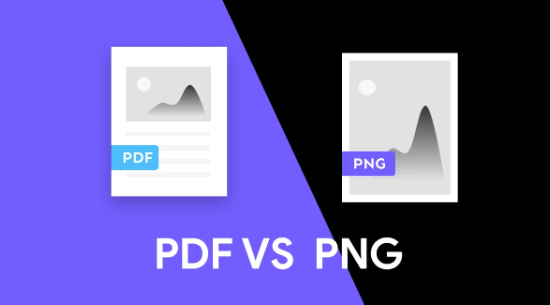When managing digital images and documents, two of the most common file formats include PNG for graphics and PDF for text/image documents. But each format offers unique capabilities that suit different use cases.
Here, we compare the inherent qualities of PNG versus PDF files like image sharpness, text rendering, compression, accessibility and more. This will help you with optimal format selection across various working needs in design, web, publishing and document management.
Understanding PNG File Format
Definition and features
PNG (Portable Network Graphics) refers to a high-quality lossless raster graphics file format designed initially for transferring images across the internet. Key features include compressed file size through non-destructive data compression, support for 24-bit images and RGB/RGBA colors for color depth, and transparency for overlays and masks. PNG files render images crisply and cleanly at high resolution.
Pros of using PNG files
Benefits of the PNG format include broad web browser compatibility, small file sizes minimizing storage needs, lossless compression maintaining original image quality, and variable transparency for graphic overlays or removing backgrounds. PNG files also feature full metadata support for storing copyrights, edits history and other supplemental info.
Cons of using PNG files
Downsides to PNG files include lack of built-in document security like encryption, limited old software support for opening files, and increased complexity editing images across multiple layers compared to native formats like PSD Photoshop files. PNG also lacks built-in text or vector support directly in the file type.
Understanding PDF File Format
Definition and features
PDF (Portable Document Format) facilitates universal access and exchange of document files across devices and platforms. Capabilities include combining text, raster/vector graphics and multimedia into a self-contained file, adding interactivity through hyperlinks and buttons, enabling digital signatures to protect document integrity, and compressing data for reduced file size.
Pros of using PDF files
Key PDF benefits include reliable rendering of documents visually intact preserving fonts, formatting, colors and layouts, standardized file display across hundreds of apps, ability to encrypt contents for security, powerful digital rights management controls, accessibility features like tagging for impaired users, and compact file size for easy sharing via email and cloud with reliable performance.
Cons of using PDF files
Limitations of PDFs include inability to easily edit files without conversion compromising integrity, complex process of reflowing text layouts after edits, large file sizes for image-heavy documents, and lack of full print production features of professional publishing file formats. PDF also requires supplemental metadata attachment for attributes like creation date, authorship and keywords.
Quality Comparison Between PNG and PDF Files
Image quality
For photographic images and raster graphics, the PNG format provides superior sharpness, color quality and compression versus PDF for lossless image data storage and transfer. However, PDF offers broader document composition features for embedding images alongside text and vector graphics in a cohesive file.
Text quality
The PDF format significantly outperforms PNG for text handling by supporting editable fonts, custom styling like bold/italics, flowing text wrapping, hyphenation and multicolumn layouts with greater precision suitable for professional documents and ebooks.
Compression and file size
Thanks to advanced lossless data compression algorithms, PNG files achieve much greater reduction in file size versus higher quality JPEG images while retaining all original image detail. PDF documents also compress text and standard graphics efficiently but at lower ratios compared to PNG’s capabilities for photographic imagery, resulting in larger file sizes for PDFs containing many high-resolution photos.
Accessibility and compatibility
PDF documents edge out PNG images for broader compatibility and accessibility features supported across platforms and devices, aided by native handling through web browsers and operating systems. PDF viewers also incorporate assistive capabilities to aid impaired users through AI-powered reflow, tagging, alt text extraction and spoken narration.
Use Cases for PNG Files
Graphic design and artwork
PNG serves as the ideal lossless format for managing layers, masks and transparency effects during graphic design work with applications like Adobe Photoshop thanks to wider color gamut support compared to JPEG. PNG preserves layers/channels information critical for design revisions.
Web design and user interface
On the web, PNG images optimize loading performance and sharpness important for user interface elements like logos, icons and decorative graphics against transparent backgrounds across modern web browsers. Dynamic websites rely extensively on PNG’s advanced transparency support.
Transparency and image editing
Whether removing backgrounds or enabling overlapping layers as part of collages, image editors leverage PNG’s variable transparency to achieve photorealistic effects seamlessly during compositing work, unlike JPEG’s blocky artifacts when lowering opacity. Even complex multi-layer edits suffer no quality loss saving to PNG.
Use Cases for PDF Files
Document sharing and analysis
For business white papers, reports sharing, information distribution and text-oriented collaboration, PDF’s reliable rendering across 300+ devices and apps makes it the ubiquitous portable document sharing format from desktop to mobile for productivity and analysis. With recent advancements, you can even use Chat pdf AI tools to summarize, translate, or edit large PDF documents with ease.
Printing and publishing
While lacking capabilities of full desktop publishing file formats, PDF serves as the de facto standard for commercial printing workflows over less reliable Office document file types like Word and PowerPoint to guarantee consistent text, image and layout reproduction from digital to press.
Security and encryption
Sensitive documents like financial statements and contracts rely extensively on PDF’s advanced encryption protocols including AES 256-bit to restrict unauthorized access coupled with blockchain-anchored digital signatures for ensuring document integrity checks and non-repudiation while sharing via email and cloud channels.
Conclusion
In summary, while PNG and PDF adoption continues expanding across overlapping applications like mainstream Office apps integrating both file formats, each solution remains better suited for specific core use cases.
PNG provides optimized photographic image quality and transparent layering support critical for graphic design and web images. PDF facilitates text-oriented documents like reports and ebooks needing reliable layouts, security, digital rights controls and universal access across 300+ devices and apps. Understanding the inherent capabilities of PNG versus PDF guides appropriate format selection for managing digital graphics and documents.
Stay connected with: celebriches
